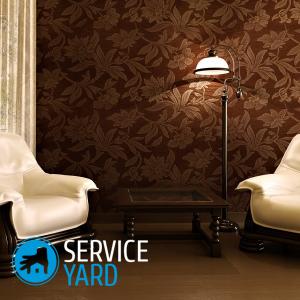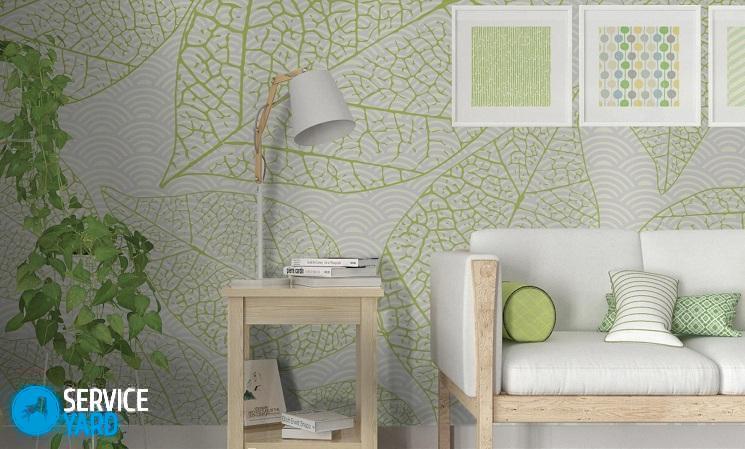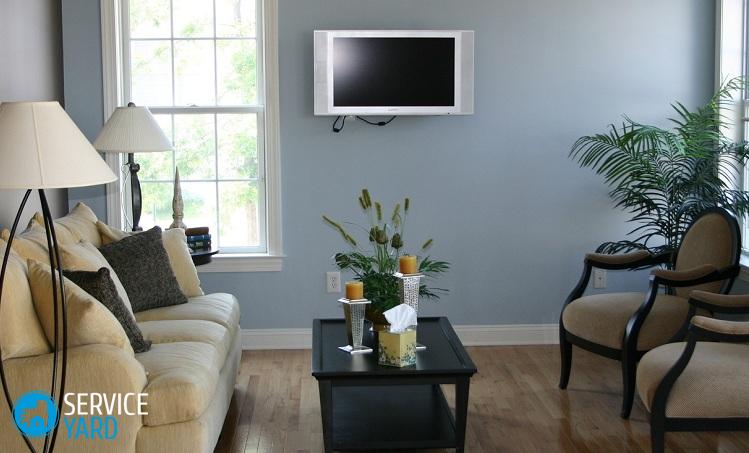How to glue glass?

Choosing finishing materials for repair, many owners prefer modern material - glass wallpaper. This very strong, durable material is an excellent solution for wall and ceiling decoration. Due to the bulkiness of fiberglass, the surface is quite smooth, homogeneous, perfectly protected from cracks and other damage. Today we will tell you how to glue wallpaper, we will pay attention to the main nuances that may arise in the process.
to contents ↑Features of fiberglass wallpaper
Fiberglass and cullet are made from the following materials:
- Quartz sand.
- Limestone.
- Dolomite.
At very high temperatures (+1200 degrees), yarn is made from the above materials. Depending on the production technology, the following types of glass are distinguished:
- Smooth. Another name for this material is fiberglass (“spider line”). Fiberglass is used in construction as a bonding material. Most often, they are reinforced with cracks, small irregularities and other defects on the surface.
- Embossed. The material is made using a different technology. First, fiber is spun from the obtained threads, and then it is woven on a machine. The texture of the material depends on the manufacturing method. For example, on ordinary machines, the textured pattern looks like geometric figures: rhombuses, Christmas trees, and jacquard machines produce more refined and complex patterns.
to contents ↑Important! The density of embossed wallpaper is much higher than that of smooth analogs, so this material is less likely to be torn or stretched during operation. Embossed wallpaper is used for the final surface finish.
Benefits
Fiberglass wallpapers in their structure are similar to fabric and have a lot of advantages:
- Strength. Of all types of wallpaper, this is the most durable material.
- High abrasion resistance. Wallpaper life exceeds 25 years.
- It does not have static charges, therefore dust is not attracted to such material.
- Provides fire safety. Due to the fact that glass fibers are treated with a special fire-fighting solution, this material can be used in rooms with sources of fire and heat.
- It does not deform under the influence of moisture.
- Does not interfere with air circulation.
- Does not allow the appearance of fungus and bacteria.
- Environmental friendliness. Natural components in the material are hypoallergenic and absolutely safe for human health.
- Possibility of painting. The textured surface of the wallpaper allows you to apply special paints on them, as a result - the walls become brighter. Cullets can be repainted up to two dozen times, while the material is able to maintain excellent shape and texture.
to contents ↑Important! All types of glass can be washed with liquid detergents and abrasives, as well as subject to disinfection and exposure to active chemicals. Due to these properties, cullet is often used in kindergartens and medical facilities.
Dimensions
Cullets come on sale in rolls with a width of 0.5 m, 1 meter, less often 2 m. The length of the canvas is 25 or 50 m.
For finishing 50 squares of the premises, one roll of 50 meters long and 1 meter wide will be enough, and with proper gluing in the corners, some of the material may even remain unused.
To take into account all the nuances and problems that may arise during work, we dwell in more detail on the question of how to properly glue the glass.
to contents ↑Technology for gluing fiberglass wallpaper
Like any construction and finishing process, wallpapering is carried out in several stages. Moreover, at any stage, all work must be carried out efficiently and responsibly, otherwise it will be difficult to achieve a decent result. Before proceeding directly to the process of wallpapering, it is necessary to carry out preparatory work.
Preparatory Activities - Walls
Before gluing cullets on the walls, it is necessary to properly prepare the surface. Proceed as follows:
- Remove the old trim. If it is necessary to remove old paper wallpapers from the wall, moisten them with water using a sponge. After the paper gets wet, remove the wallpaper with a spatula. If the walls are painted with water-based paint, then wash the surface with water and a rag. Remove oil paint with a special wash.
- Clean the surface and remove any protruding elements (nails, screws).
- Putty all defects on the surface and places with fittings.
- Allow the surface to dry and sand it with sandpaper.
- Level the surface thoroughly and apply a primer. As a composition for the primer, you can use a special tool or liquid glue.
Important! Treat the surface primer responsibly, since the hitching of the wallpaper to the walls depends on it.
Advice:
- If the room in which the wallpaper will be glued is wet and has a tendency to mold, then treat the walls with a fungicidal composition, and then prime the working surface.
- If you plan to glue the cullet for painting on drywall, then the surface of the walls can not be putty, but the gypsum board itself must be putty necessarily. Firstly, through thin wallpaper, the joints of sheets and the head of the screws will be visible. Secondly, during subsequent repairs, pieces of glass will have to be torn off together with pieces of a gypsum layer.
Preparation of the premises
The room in which finishing work will be carried out also needs to be prepared. Proceed as follows:
- Close all windows and doors to avoid drafts.
- Make sure that the temperature in the room is not lower than + 18-20 degrees, and the humidity is not higher than 70%.
- Curtain windows to prevent direct sunlight from entering the walls.
Tools for work
Before gluing cullets for painting, prepare the following tools:
- Plummet for vertical control.
- Roller for priming the surface and applying glue.
- Roller for rolling wallpaper. For this purpose, you can use a plastic spatula.
- A sharp knife and a ruler for cutting wallpaper.
- Narrow brush for working in hard to reach places.
- Capacity for glue dilution.
- Rubber gloves and work clothes with long sleeves. Protect the body, hair and hands from particles of glass, which very often irritate the skin.
- Reliable stepladder.
- Foam sponge.
The choice of glue for glass
A very important step in the preparation of wall gluing is the selection of glue and the preparation of an adhesive.
Important! Do not use ordinary wallpaper glue or a composition for heavy types of paintings, since the long-term operation of the finishing material depends on the quality of the adhesive composition.
Manufacturers of fiberglass cloths offer a special adhesive that is perfectly diluted with water. An excellent solution is the Oscar glue with colored pigment, which allows you to control the uniformity of the composition on the surface.
You can use universal compositions for glass, resistant to low temperatures, for example:
- Kleo Ultra;
- Security GK 10;
- Pufas.
Important! It is recommended to dilute these compounds with water to a certain consistency. When choosing glue, pay attention to the information contained on the container. The bank must have a record: “for fiberglass wallpaper”. How to prepare the adhesive composition is also indicated in the instructions on the package.
Advice:
- For walls with mold, we recommend using compounds with fungicides, for example, “Kelid non-woven” or “Kelid special vinyl”.
- Some canvases do not need glue, because they have already been applied adhesive composition. In order to glue such canvases to the surface, just moisten them with water. These products include Vitrulan Aqua Plus fiberglass wallpaper.
How to glue wallpaper for painting on the walls?
The process of gluing fiberglass wallpaper is not much different from the standard wall decoration procedure. We note only some nuances:
- The equipment of a working person should protect him from particles of fiberglass.
- Cloth fiberglass wallpaper has a wrong side and front side. The front side is located inside the roll, and the wrong side has a grayish or bluish tint and is marked by the manufacturer.
- Cut strips of material should be a sharp kitchen or mounting knife in a ruler. When cutting strips, do not forget to leave an allowance of 5-10 cm wide, depending on the unevenness of the floor, ceiling, the presence of baguettes and baseboards.
Step-by-step instructions for sticking fiberglass wallpaper on the walls:
- Mark vertical lines on the wall with a plumb line. On these lines in the future you will be guided by aligning the stripes vertically.
- Cut strips of material with a small allowance that compensates for pattern matching.
- Dissolve glue according to the instruction.
- Apply glue to the wall with a roller or plastic spatula (to the width of one strip). In hard-to-reach places (corners, near switches and sockets), glue with a brush.
- Attach the top edge of the strip and align it with a plumb line. Press the top edge and roll in the middle of the strip with a wallpaper roller. It is better to glue the strips together: one - puts the top on the stepladder, and the other - works at the bottom.
- Press the canvas against the wall all the way, starting from the middle and moving to the edges.
- Lay all strips end to end without gaps or gaps. Use a spatula and a sponge to remove air and excess adhesive. Pay special attention to the reliability of gluing the edges of the fiberglass, otherwise it may break.
- After gluing the cullet, apply glue diluted with water on top of them to simplify the application of paint.
- Leave the finishing material for a day to dry. The drying time of the material varies from a day to two, in rare cases, this process can take a longer time.
- At the end of the work, cut off the allowances with a knife.
How to glue the cullet on the ceiling?
For work you will need the following tools:
- Soft paint rollers.
- Whitewash brush.
- Set of metal spatulas.
- Water tank and glue tray.
- Paint cord for marking.
- Sharp knife.
- Pencil or marker.
- Ladder.
Since wallpaper refers to the finishing material, for which the base must necessarily be as even and smooth as possible, the process must begin with the preparation of the surface:
- Carefully inspect the ceiling and identify the areas with the most damage (areas of exfoliated plaster).
- Rinse whitewash from the ceiling with a soft brush, rags, and warm soapy water.
Important! Sprinkle perennial exfoliations beforehand with water and remove with a sharp metal spatula.
- Apply a primer coat to the surface with a soft roller.
- After the putty dries, sand the entire surface with sandpaper.
- Apply a second coat of primer just before gluing the ceiling wallpaper.
Important! You can use any primer designed for finishing work. Use a paint roller made of foam rubber or wool as a tool.
- Allow the surface to dry completely.
Important! If the ceiling is finished with plasterboard, then before gluing the wallpaper, seal all joints with putty and sand it with sandpaper.
Step-by-step instructions for gluing the ceiling:
- Mark the ceiling. Make marks on both sides, using a masking line, draw a longitudinal line. The first roll will be glued along the planned line.
- Cut the wallpaper, according to the measurements. Use a metal ruler to keep the cut even.
- Prepare the adhesive according to the instructions.
- Apply glue to the ceiling surface with a paint roller. Try to ensure that the working width does not exceed the width of the blade.
- Put the canvas on the ceiling, gradually fix it along the entire length.
- Smooth the canvas with a wide plastic spatula.
- Glue the next sheet end-to-end with the previous one.
- After the entire ceiling has been pasted, apply a layer of thick glue to the surface for subsequent optimal staining.
- After the cullets are completely dry, they can be painted.
to contents ↑Important! To make all the work more convenient, take note of the following tips:
- The process of gluing cullets on the ceiling is carried out together, since one person cannot hold the canvas and at the same time smooth it.
- When painting the ceiling, glue the perimeter with masking tape to protect the walls from spray.
Fiberglass painting
After the final drying of the finishing material, proceed to painting:
- Water-dispersed latex paints are used for staining glass.
- Before applying paint to the wallpaper, the surface of the finish should be treated with a primer in the form of diluted glue. This will help reduce material consumption because the porous structure of the fiberglass absorbs paint very quickly.
- Apply paint to the canvas in two layers. Apply the first coat no earlier than two days after wallpapering, and the second one 12 hours after the first staining.
to contents ↑Important! Paint consumption depends on the density of fiberglass wallpaper. On average, about 500 g of paint is spent per 1 sq. M of surface; for denser paintings, consumption will increase.
Tips for choosing fiberglass wallpaper:
- When choosing a finishing material, remember that the quality of fiberglass wallpaper is determined by the density per square meter. m. Good wallpaper has a density of 100 g per 1 square. m and above. Some manufacturers produce very dense products with an indicator of up to 200 g per 1 sq. m
- Choose a wallpaper with a lower density and lower texture on the ceiling. Suitable species such as "herringbone" and "cobweb." For walls it is preferable - “rhombus” and “matting”. These types of cullets have a clearer relief, which means that they can be repainted a large number of times.
- Cullets with a density of less than 100 g per 1 square. m are usually less embossed, so you can repaint them only 1-2 times.
- For painting, choose colorless wallpaper, and for the finish - with a color pattern.
Stock footage
Modern types of finishing materials provide customers with an extremely wide selection. Today we talked about how to glue wallpaper for painting. Of course, the material is very demanding on the preparation of the foundation and is not cheap. In addition, the purchase of a special adhesive will also affect the repair budget, but high-quality fiberglass wallpapers with strength, resistance to moisture and durability will last for many years without causing any hassle in caring for them!
- How to choose a vacuum cleaner taking into account the characteristics of the house and coatings?
- What to look for when choosing a water delivery
- How to quickly create comfort at home - tips for housewives
- How to choose the perfect TV - useful tips
- What to look for when choosing blinds
- What should be running shoes?
- What useful things can you buy in a hardware store
- Iphone 11 pro max review
- Than iPhone is better than Android smartphones






